Amymone and Poseidon
It is rare to find several, chronologically linked episodes of a story depicted in a mosaic. The doubling or even freeze-like repetition of protagonists and settings is highly unusual. All the more interesting, therefore, is a mosaic image from Chania showing two key scenes from the Amymone myth.
In 1937 in the city of Chania in west Crete a polychrome mosaic floor with figurative decoration was found. Research findings and style suggest that the mosaic dates from the second half of the 3rd Century.
The pavement originally decorated a
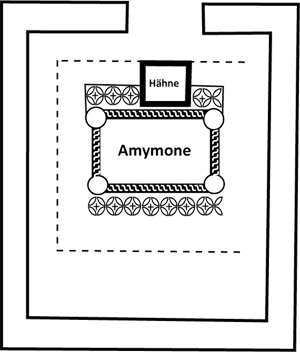
The mosaic image faces the rear wall and so could best be seen by whoever was situated on the eastern side of the room. The exceptional composition in the main image of the pavement provided the impetus for this study.
In the centre of the floor is a large area in which two scenes from the Amymone myth are depicted. The composition, featuring four figures, is surrounded by a simple plaited frame which is intersected at each of its four corners by medallions showing the head of Medusa (fig. 2. 5). The faces of the Gorgons look in various directions and have no relation to the mythical scenes depicted.
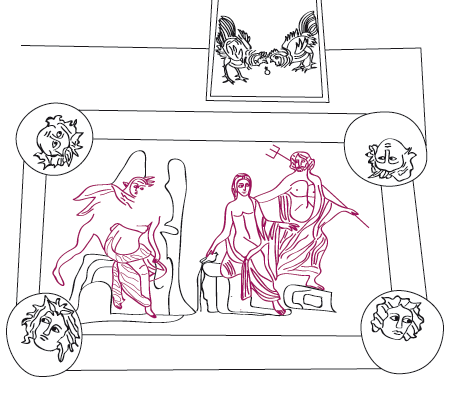
The threshhold mosaic on the west side shows two fighting cocks (fig. 3-4), leaning down towards a pomegranate that lies between them.
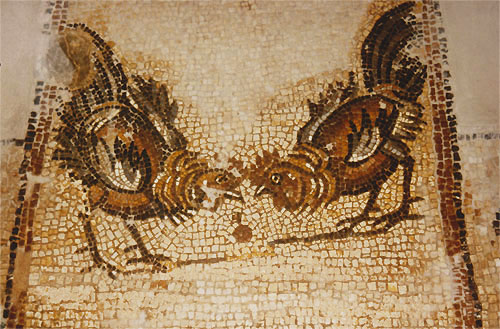

The framing geometric pattern consists of overlapping circles drawn in black lines against a white background. Within the concave square are large cross-shaped stars [2]. The klinai were presumably placed on the plain white external part of the mosaic.
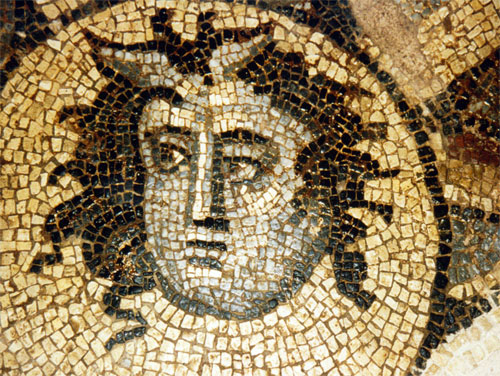
The figure of Amymone is depicted twice in the main image. She appears in
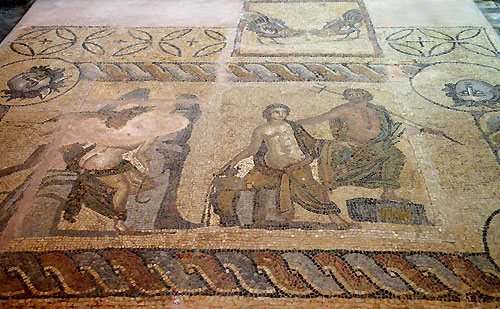
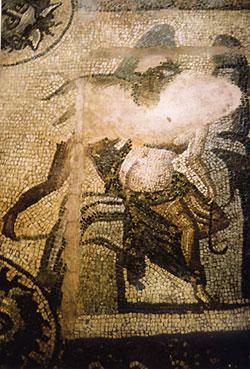
In the image’s right half Amymone is harmoniously united with her liberator and lover Poseidon at a spring. The sea god stands in a heroic pose on a raised platform and places his right hand protectively on Amymone’s shoulder. With a lekythos the nymph scoops water from a bubbling spring.
The mosaic portrays
The mosaic artist concentrated on reproducing
The two scenes are not, as is usually the case, divided by a line or ornamental band. As a result, the centre of the image remains curiously empty, without anything to catch the eye. At the same time, the artist tried to lend the composition a certain coherence by having the figures symmetrically facing two imaginary diagonal points. The empty centre is framed by the two representations of Amymone – on the left forcefully suppressed, on the right kneeling. The symmetrical structure is continued with the male figures: on the left the lecherous satyr, while on the right Poseidon stands in a heroic pose with his raised trident.
As an inferior being, the satyr is granted less space than the god. He is portrayed with his upper body bent forward and with his weight on one knee, although the cliffs in the background form a compositional counterbalance to the form of Poseidon.
That the artist from Chania wasn’t a true master of his trade is demonstrated by the somewhat
Several inconsistencies are particularly notable in the figure of Amymone on the right: she supports herself by means of her right knee on the upper edge of a rectangular block. Her leg is bent, the calf for the most part not visible. However, shading on the hip creates the impression that the right leg is stretched out to the left.
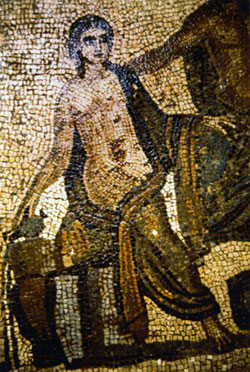
The mosaic artist also failed to combine the buttocks and legs organically in the Amymone figure on the left. The exposed buttocks are far too wide for the narrow, rather poorly executed upper thighs (fig. 6-7).
Ambiguities are also present in the representation of the various surfaces and landscape elements. The scene on the left takes place in a ravine. The summit of a steep cliff is visible above the satyr, but it only continues down to the point where the hybrid creature is situated. The cliff top thus floats incongruously in the air.
In the set of figures on the right Poseidon stands on a higher level than Amymone. The foot of his slightly bent left leg rests on a rectangular block. However the progression of his right leg, which stretches to the rear, is hard to follow (fig. 6. 8). The cloak and thigh of the god end abruptly at the point where Amymone’s garment begins. The vertically hanging fabric effectively denotes a boundary between the nymph and sea god.
Another aspect that stands out is the insufficient corporeality of the figures, which can be traced back to the dominance of dark contour lines and the crude representation of light and shadow. Their movements appear jerky and tense.
The artist demonstrates more skill in the depiction of the two fighting cocks in the threshold mosaic. He managed to convincingly portray the birds in their combative stance. He was more successful in the decorative drawing of the bird contours and feathers than in the complex and irregular progression of the human bodies. It can’t be entirely ruled out that a different mosaic artist may have been at work here (fig. 3-4).
The frequent repetition of certain themes and figures in Roman mosaics leads to the supposition that the craftsmen availed of
Representations of the Amymone myth can be found throughout the empire. The mosaic images usually portray Amymone together with Poseidon. The brutal image of Amymone’s pursuit by the satyr appears only rarely [3].
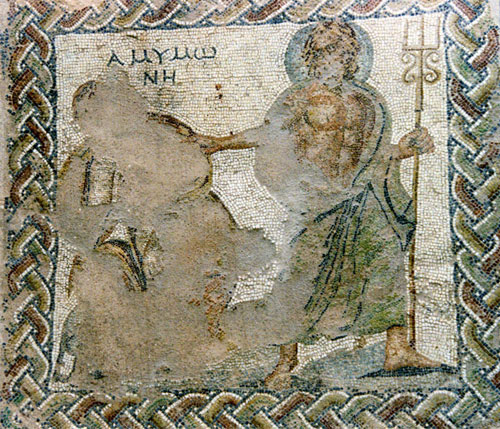
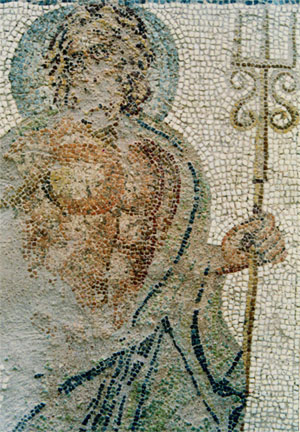
In the northern Greek city of Amphipolis another Amymone mosaic was excavated in the early 1970s (fig. 9-10) [4]. nstead of the satyr, the kidnapping of the Greek hero Hylas by nymphs was depicted in the accompanying image (fig. 11-12) [5]. Hylas, a beautiful youth and lover of Heracles, wanted to fetch water from a spring in Cius (Propontis). The water nymphs saw him and, overwhelmed by his beauty, dragged him down to the depths. Heracles hurried to help his friend, but in vain.
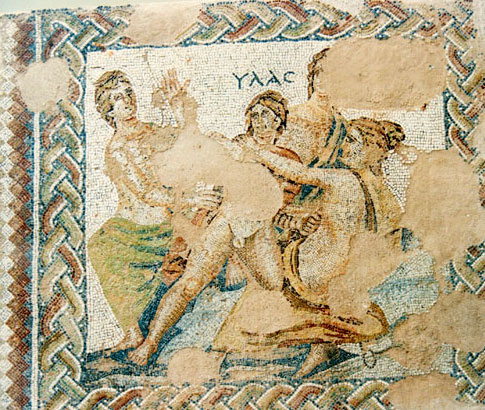

As was the case in Chania, the
Both images are linked by the close relationship of the acting figures to water. Stretching back to Hellenistic times, water as a source of life and also as a cause and symbol of fertility plays an important role in numerous floor mosaics [6].
The images of Amymone in Amphipolis and Chania are clearly both based on the same model, though whether that was a famous painting or a group of statues from the Hellenistic era can no longer be determined.
In Amphipolis the figures of Poseidon and Amymone are more clearly separated from one another. The progression of individual limbs and garment parts is therefore easier to follow. Poseidon is represented in the same standing pose as in Chania, although in this case his left foot is positioned not on a platform, but rather a shaded surface which continues under the feet of Amymone. The naked torso is particularly vivid. The breast area exhibits almost feminine curves. Of the downward flowing hip cloak only fragments remain. Several folds in gentle green tones can be recognised. Compared to the mosaic in Chania the figures have greater physicality and a stronger relationship to one another. The fact that they are also more skilfully placed within a relatively small frame could place the compositional date earlier in the first half of the 3rd Century.
In the mosaic in Chania various aspects of Greek and Roman iconography are combined.
The fighting cocks and the Amymone scenes are clear
The representation of several sequentially linked episodes of a story is rare in mosaic composition [9]. The use of doubling or repetition is extremely unusual [10]. This makes the mosaic from Chania all the more remarkable. Parallel cases have only been found so far in mosaics in Syria and North Africa [11].
There are early forms of sequential story telling in ancient Oriental art [12]. There the scenes are combined as in a frieze. Comparable to a
The earliest significant work showing episodes from an entire life is the
Not until Roman times does sequential story telling gain in importance. The most significant example of this monumental art is the
Numerous examples of sequential visual story telling appear on Roman sarcophagi. The relief on the long frontal side is often divided into three sections [16].
It seems plausible that the few thus far discovered
A. Kankeleit, Kaiserzeitliche Mosaiken in Griechenland, Dissertationsdruck Bonn 1994 Band II Katalog Nr. 2 und Nr. 81; A. Kankeleit, Der Amymonemythos auf Mosaiken in Griechenland, Forum Archaeologiae 12/IX/99; B.Ph. Theophaneidis, AEphem 1945-47, 37ff. Fig. 1-8; KretChron 13, 1959, 392; Ph. Bruneau, Le motif des coqs affrontés dans l'imagerie antique, BCH 89, 1965, 90ff. (insbes. 108f.) Fig. 16. 17; F. Berti, Poseidon ed Amymone. Un mosaico romano di Chania, ASAtene 50-51, 1972-73 (N.S. 34-35), 451ff. Fig. 1. 3. 5. 6; J. Tzedakis, ADelt 33, 1978, 364ff. Plate 190,4; LIMC I (1981) 742 Nr. 16. 30 s.v. Amymone (E. Simon); J. F. Sanders, Roman Crete (1982) 54; C. Mc Keon Hessenbruch, Iconology of the Gordon Medusa in Roman Mosaic (Ph .D. Microfilm, Ann Arbor 1984) 423 Nr. 48; A. Kophou, Kriti (1989) 257 Fig. 333; BAssMosAnt 12, 1988-1989, 164 Nr. 1185.
https://www.flickr.com/photos/dandiffendale/8688902977/in/photostream/
https://www.flickr.com/photos/7549203@N04/4507700472/
[1] My sincere thanks go to the Ephorate of Prehistoric and Classical Antiquities in Chania and especially Stavroula Markoulaki for her help in photographing and researching the mosaic.
[2] The four-pointed stars show a form characteristic for late antiquity, cf. W. Jobst, Römische Mosaiken in Salzburg (1982) 100; W. Jobst, Römische Mosaiken aus Ephesos I. Forschungen in Ephesos VIII,2 (1977) 82ff.; C. Balmelle u.a., Le décor de la mosaïque romaine. Répertoire graphique et descriptif des compositions linéaires et isotropes (1985) Plate 4,f.
[3] J.-P. Darmon, Nymfarum domus: Les pavements de la maison de Nymphes à Néapolis (Nabeul, Tunisie) et leur lecture (1980) 188f. Taf. LII. LIV. LXXXII; LIMC I (1981) 742 ff. in particular 743. 752 s.v. Amymone.
[4] My deep gratitude to the 12th Ephorate of Byzantine Antiquities in Kavalla for permitting me to research and reproduce the mosaic; zum Amymonemosaik von Amphipolis s. Ergon 1975, 53ff.; LIMC I (1981) 744 Nr. 29 s.v. Amymone (E. Simon).
[5] For more about this theme see S. Muth, Erleben von Raum - Leben im Raum. Zur Funktion mythologischer Mosaikbilder in der römisch-kaiserzeitlichen Wohnarchitektur (1998) 100ff. (101. 344 zum Mosaik in Amphipolis); LIMC V (1990) 574ff. Nr. 15 s.v. Hylas (J.H. Oakley).
[6] See author’s text: Images of fish and fishermen on mosaics in Greece.
[7] Ph. Bruneau, BCH 89, 1965, 90ff.114 Fig. 16.17 Nr. 62.
[8] K.M.D. Dunbabin, The Mosaics of Roman North Africa (1978) 163; C. Mc Keon Hessenbruch, Iconology of the Gordon Medusa in Roman Mosaic (Ph.D. Microfilm, Ann Arbor 1984) 102f.; A. Panayotopoulou, Représentations de la Meduse dans les mosaïques de Grèce, in: VI Colloquio internacional sobre Mosaico antiguo. Palencia-Mérida, Octubre 1990 (1994) 376 Note 30.
[9] About "continuous narrative" (sequential storytelling): cf. H. Froning, Anfänge der kontinuierenden Bildererzählung, JdI 103, 1988, 169ff.
[10] The Heracles Cycle is an exception. In a frieze or circular composition the hero is depicted in each act; for more about Heracles mosaics in Greece see A. Orlandos, Prakt 1963, 146f. Plate 121-124 (Paros); E. Skarlatidou, in: Symposio "I istoriki, archaiologiki kai laografiki erevna gia tin Thraki" (1988) 109ff. Fig. 7-13 (Didymoteicho); N. Yalouris, in: KOTINOS, Festschrift E. Simon (1992) 426ff. Plate 91-92 (Elis).
For the difference between cyclical and sequential forms of representation see Froning ibid 177ff.
The chronological order of events is of minor importance in cyclical representations.
[11] e.g. the mosaik from Hippodamia, Shahba (Syria) with three stages of the Pelops saga: J. Balty, Mosaïque antiques du Proche-Orient (1995) 65. 70. 144. 340 Plate 8,2; J. Balty, La mosaïque en Syrie, in: J.M. Dentzer - W. Orthmann (Hrsg.), Archéologie et histoire de la Syrie II (1989) 498ff. Fig. 175; J.M. Blázquez, Mosaicos Romanos de España (1993) 575 Fig.
Mosaic with three scenes from the Marsyas myth in Dougga (Tunisia): M. Fantar, Le mythe de Marsyas sur deux nouvelles mosaïques de Tunisie, in: "L´Africa romana". Atti del IV convegno di studio, Sassari, 12-14 dicembre 1986 (1987) 151ff. Plate 6. 8-12.
[12] Froning ibid 180.
[13] N. Himmelmann, Erzählung und Figur in der archaischen Kunst, AbhMainz Nr. 2 (1967) 73ff.
[14] H. Heres, Der Telephosfries in Pergamon, in: W.D. Heilmeyer (Hrsg.), Der Pergamonaltar. Die neue Präsentation nach der Restaurierung des Telephosfrieses (1997) 102.
[15] W. Gauer, Untersuchungen zur Trajanssäule. MAR XIII (1977) 9ff.; L.E. Baumer - T. Hölscher - L. Winkler, Narrative Systematik und politisches Konzept in den Reliefs der Traianssäule. Drei Fallstudien, JdI 106, 1991, 261ff.
[16] Examples in G. Koch - H. Sichtermann, Römische Sarkophage (1982) 63f. 131ff.
[17] see Note 11.